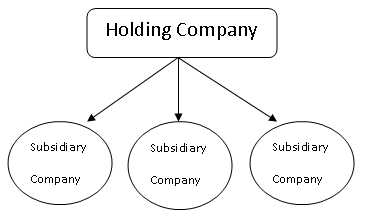Introduction Minority interest refers to the interest of the outsiders in the subsidiary or subsidiaries of a holding company. In the presentation of the consolidated balance sheet of a parent company and its subsidiaries, Minority Interest is shown just below Shareholders’ Funds. Explanation To undRead more
Introduction
Minority interest refers to the interest of the outsiders in the subsidiary or subsidiaries of a holding company. In the presentation of the consolidated balance sheet of a parent company and its subsidiaries, Minority Interest is shown just below Shareholders’ Funds.
Explanation
To understand the concept of minority interest, we need to first understand the relationship between a holding company and its subsidiary company or companies.
A holding company means a company that controls one or more companies by:
- Holding more than fifty percent of the total voting rights or equity share capital.
- having the power to appoint or remove the majority of the board members.
A subsidiary company is a company that is controlled by another company.

From the above, we can simply deduce that a holding company holds the majority of the equity in its subsidiary company or companies.
So, the equity of the subsidiary company which does not belong to the holding company, but to the outsiders is known as the minority interest as it is, in fact, the minority in comparison to the majority stake of the holding company.
Example
For example, A Ltd holds 75% of the equity in B Ltd, then the rest 25% which belongs to the outsiders will be the Minority Interest.
Minority Interest means the share of outsiders in the:
- Paid-up share capital of the subsidiary
- Reserve and Surplus
For example, B Ltd has the following particulars under Shareholders’ Funds.
| Equity Share Capital | Rs. 10,00,000 |
| Revaluation Reserve | Rs. 4,00,000 |
| Balance of Profit and Loss A/c | Rs. 1,00,000 |
| General Reserves | Rs. 5,00,000 |
B Ltd is a subsidiary company of the A Ltd. A Ltd holds 75% of B Ltd.
It means minority interest in B Ltd is 25% (100% – 75%)
Therefore, in the consolidated balance sheet of A Ltd and its subsidiary, the minority interest will be as follows:
Minority Interest in B Ltd (25%)
| Equity Share Capital | Rs. 2,50,000 (10,00,000 x 25%) |
| Revaluation Reserve | Rs. 1,00,000 (4,00,000 x 25%) |
| Balance of Profit and Loss A/c | Rs. 25,000 (1,00,000 x 25%) |
| General Reserves | Rs. 1,25,000 (5,00,000 x 25%) |
| Total | Rs. 5,00,000 |
See less

Revaluation of Assets is an adjustment made in the carrying value of the fixed asset in case the company finds there is a difference between the current price and the market value of the asset. Generally, the value of the asset decreases due to depreciation but in some cases like inflation in the ecRead more
Revaluation of Assets is an adjustment made in the carrying value of the fixed asset in case the company finds there is a difference between the current price and the market value of the asset. Generally, the value of the asset decreases due to depreciation but in some cases like inflation in the economy, it may increase. so, in order to know the correct value of the asset Revaluation is to be done.
Accounting standard allows two models.
Under the cost model, the carrying value of fixed assets equals their historical cost less accumulated depreciation and accumulated impairment losses.
For Example, Amazon ltd purchased a Plant for 5,00,000 on January 1, 2010, with a useful life of 10 years, and uses straight-line depreciation.
Here, the journal entry would be passed as
As the useful life of the asset is 20 years, so the yearly depreciation would be
5,00,000/10 i.e. 50,000.
So the accumulated depreciation at the end of December 31, 2012, would be 50,000×2= 1,00,000 and
the carrying amount would be 5,00,000-1,00,000= 4,00,000.
Under the Revaluation method, the assets are revalued at their current market value. If there is an increase in the value of an asset, the difference between the asset’s market value and current book value is recorded as a revaluation surplus.
For Example, Amazon ltd purchased an asset two years ago at a cost of 2,00,000. Depreciation @ 10% under straight-line method.
Therefore, the accumulated depreciation for two years would be 40,000,
i.e. 20,000 for a year.
Carrying cost of the asset = 1,60,000
Assuming, the company revalues its assets and finds that the worth of assets is 1,85,000.
Under this method, the company needs to record 25,000 as a surplus.
Accounting entry for the above will be
Depreciation calculated during the third year would be based on the new carrying value of 1,60,000.
Therefore, Depreciation for the 3rd year= 1,60,000/3
= 53,333.33
Accounting entry:
Alternatively, the incremental depreciation due to the revaluation i.e. 13,333.33 can be charged to the revaluation surplus account.
In case, if there is a revaluation loss, the entries would be interchanged.
In case of admission of a partner, the new partner may not agree with the value of assets as stated in the balance sheet, with time the values may have arisen or may have fallen, so in order to bring them to their correct values revaluation is done so that the new partner doesn’t suffer.
Where the assets and liabilities are to be shown in the books at the revised (new) values after the admission of the new partner.
The accounting entries are
2. For a decrease in the value of an asset
3. For transfer of profit on revaluation i.e. if the total of credit side exceeds the debit side.
4. For transfer of loss on revaluation i.e. if the total of debit side exceeds the credit side.
Note: If the total of both sides is equal it signifies that there is no profit or loss on the revaluation of assets. Hence no entry is to be passed.
After preparing for the journal entry, a revaluation ledger account is also prepared wherein the accounts carrying a debit balance are transferred to the debit side and the accounts carrying a credit balance are transferred to the credit side.
In the case of retirement of a partner, the same journal entries are to be passed as in the case of Admission of a partner for revaluation of assets.
Generally, the value of an asset decreases with time but it may increase in certain circumstances especially in inflationary economies.
Conclusion
An entity should do the revaluation of its assets because revaluation provides the present value of assets owned by an entity and upward revaluation is beneficial for the entity and hence the company can charge more depreciation on upward revaluation and can get tax benefits.
See less